Get important questions of General Properties of Matter for Board exams. Download or View 11th Physics important questions for exam point of view. These important questions will play significant role in clearing concepts of Physics. This question bank is designed by NCERT keeping in mind and the questions are updated with respect to upcoming Board exams. You will get here all the important questions for class 11 Physics chapter wise CBSE.
Click Here for Detailed Notes of any chapter.
eSaral provides you complete edge to prepare for Board and Competitive Exams like JEE, NEET, BITSAT, etc.
We have transformed classroom in such a way that a student can study anytime anywhere. With the help of AI we have made the learning Personalized, adaptive and accessible for each and every one.
Visit eSaral Website to download or view free study material for JEE & NEET.
Also get to know about the strategies to Crack Exam in limited time period.
Q. What is the value of young’s modulus for perfectly rigid body.
Ans. Infinite
Q. What is the value of bulk modulus for an incompressible liquid ?
Ans. Infinite
Q. What is the value of modulus of rigidity for any liquid ?
Ans. Zero
Q. How does young’s modulus change with rise in temperature.
Ans. Young’s modulus of material decreases with rise in temperature.
Q. Which type of strain is there, when a spiral spring is stretched by a force ?
Ans. Shear strain.
Q. The ratio stress/strain remains constant for small deformation. What will be effect on this ratio when the deformation made is very large ?
Ans. When the deforming force is applied beyond elastic limit, the strain produced is more than that has been observed within elastic limit. Due to which the ratio stress/strain will decrease.
Q. Which of the three Y,K, and h is possible in all the three states of matter (solid, liquid and gas)
Ans. Bulk modulus of elasticity (K) only
Q. Give the example of a body which is nearly perfectly elastic.
Ans. Quartz fibre.
Q. Give the example of a body which is nearly perfectly plastic
Ans. Putty.
Q. What do you mean by elastic hysteresis ?
Ans. On reducing the stress to zero the material does not recover. Its unstrained state as some strain always remain. This phenomenon of lagging of strain behind the stress, is called elastic hysteresis.
Q. What do you mean by an elastomer ?
Ans. The materials which has large elastic limit but do not obey Hook’s law, are called elastomers.
Rubber is a very good example of such type of material.
Q. Diamond is called a hard material. What does it mean in term of its modulus of elasticity?
Ans. Modulus of elasticity becomes large. It means it becomes more elastic.
Q. Paints and lubricating oils have low surface tension. Why?
Ans. Being of low surface tension, they spread over a large surface area.
Q. A piece of chalk immersed in water emits bubbles in all directions. Why?
Ans. Chalk has pores all over its surface which acts as fine capillaries. When immersed in water, the water rises into these capillaries and forces the air out in the form of bubbles in water all around.
Q. A mercury barometer reads slightly less than the actual pressure. Why?
Ans. This is because, due to capillary action, mercury is depressed down in the barometer tube.
Q. Some straw are spread on the surface of pure water filled in a vessel. On dropping a piece of sugar in water, the straw come nearer to the piece, but on dropping a piece of soap, they go away from it. Explain.
Ans. The surface tension of sugar solution is greater than that of pure water. Therefore, the surface contracts near the piece of sugar and hence straw come nearer it. The surface tension of soap solution is less due to which the surface spreads near it and straw go away from it.
Q. If the free surface of liquid is plane. Where does the force of surface tension act?
Ans. The surface tension acts horizontally, and has no component normal to surface.
Q. When pure water falls on a flat glass plate it spreads on the plate while the mercury when falls on a glass plate gets converted into small globules. Why?
Ans. The adhesive force of mercury and glass is less than that of their cohesive force. Therefore, Hg breaks into droplets.
Q. What are the properties of an ideal liquid ?
Ans. An ideal liquid is one that is perfectly incompressible, non-viscous and unable to withstand shearing stress, however small.
Q. Which one is most viscous among water, air, blood and honey ? Which one is the least viscous ?
Ans. Honey is most viscous and air is least viscous.
Q. When oil flows in a pipe, which layer moves fastest ?
Ans. The axial layer moves fastest.
Q. Hot liquid flows more rapidly than cold one, why?Ans.The coefficient of viscosity of a liquid decreases with rise in temperature. Hence, hot liquid flows with larger speed than when it is cold.
Q. Why are machine parts usually jammed in winter?
Ans. This is because the lubricant used in the machine becomes more viscous in winter.
Q. According to Bernoulli’s theorem, the pressure of fluid should remain uniform in a pipe of uniform radius. But actually it goes on decreasing. Why is it so ?
Ans. It is due to viscosity of fluid. When fluid flows, work is done against the viscous force, and this work is taken from the pressure energy. Hence pressure fluid falls.
Q. If instead of fresh water, sea water is filled in the tank, will the velocity of efflux change ?
Ans. No, velocity of efflux does not depend upon density of liquid.
Q. Which is easier to lift in the air; 1 Kg steel or 1 Kg cotton ? What will be your answer if we lift these object in vacuum ?
Ans. In case of air, it will be easier to lift 1 Kg of cotton because it will displace greater volume of air and lose more weight. In case of vacuum, as there will be no upward buoyant force on the objects, hence both will weight equally.
Q. Which fundamental law forms the basis of equation of continuity ?
Ans. Law of conservation of mass.
Q. Why water is not used in barometers ?
Ans. On account of following reasons, water is not used in barometers :
(i)Water sticks to the walls of the barometer tube.
(ii) Water has low density so height of water column becomes very large (11m) which is unmanegeable.
Q. Why the boiling point of a liquid varies with pressure ?
Ans. At boiling point, vapour pressure of liquid is equal to the atmospheric pressure. Hence, when the atmospheric pressure on the surface of liquid increases, the liquids boil at higher temperature to generate greater vapour pressure.
Q. Why water does not flow out of a dropper unless the rubber bulb is pressed ?
Ans. The upward air pressure at the dip of dropper is equal to the pressure of liquid column in it. When we press the rubber bulb, the inward pressure increases making the liquid flow out.
Q. What is the fractional volume submerged of an ice cube in a pail of water placed in an enclosure which is falling freely under gravity ?
Ans. Because the pail of water is falling freely under gravity, hence it will be in a state of weightlessness. Both the weight of the ice cube and the upthrust would be zero. So, the ice cube can float with any value of fractional volume submerged in water.
Q. A wooden block is in bottom of a tank when water is poured in. The contact between the block and the tank is so good that no water gets between them. If there a buoyant force on the block?
Ans. Since, there is no water under the block to exert an upward force on it, therefore there is no buoyant force.
Q. What is hydrostatic paradox ?
Ans. According to it the pressure exerted by a liquid depends only upon the height of liquid column and is independent of shape of the containing vessel.
Q. Why the wings of an aeroplane are rounded outwards while flattened inwards ?
Ans. Due to such shape of the wing, the velocity of air relative to the wind on the upper surface is larger than that of lower surface. This causes the pressure difference. The pressure below the wing is more than above the wing and hence causes upward lift on the aeroplane.
Q. To keep a piece of paper horizontal, one should blow over it and not under it. Why ?
Ans. When we blow air over a piece of paper, the velocity of air moving along the upper surface of paper is higher than that along the lower surface. Therefore, the air pressure on the upper surface of paper is lowered (according to Bernoulli’s theorem), while the pressure on the lower surface is still atmospheric. Due to higher pressure below the paper, the paper stays horizontal and does not fall under gravity.
Q. A balloon filled with helium does not rise in air indefinitely but halts after a certain height (Neglect winds). Explain why ?
Ans. A balloon filled with helium goes on rising in air so long as the weight of air displaced by it (i.e. upthrust) is greater than the weight of filled balloon. We know that the density of air decreases with height. Therefore, the balloon halts after attaining a height at which density of air is such that the weight of air displaced just equals the weight of filled balloon.
Q. Two tooth picks floating on a water surface are parallel and close to each other. A hot needle is touched between them to the water surface. Explain why they fly apart ?
Ans. When a hot needle is touched between them to the water surface, the surface tension of water in this region decreases due to increase in temperature. So, the outward pulling force due to surface tension of water on either side is more. Hence they fly apart.
Q. The hot soup is tastier than the cold one. Why?
Ans. Since, the surface tension of liquid decreases with rise in temperature. Therefore, the
surface tension of hot soup is less than that of cold soup. Hence, hot soup spreads over a larger area of the tongue and gives a tastier feeling.
Q. Small insects swimming on water die when kerosene oil is added into the water. Why?
Ans. Insects swim on water surface because of surface tension due to which surface behaves like a stretched membrane. On adding kerosene oil, the surface tension is appreciably reduced and the insects sink to death.
Q. Discuss the various application of elasticity.
Ans. Some of the important applications of the elasticity of the material are discussed as follow.
(1) Bridges are declared unsafe after long use.
(2) A metallic part of a machinery will get permanently deformed if subjected to a stress beyond the elastic limit. Therefore, the metallic part of the machinery is never subjected to the stress beyond the elastic limit.
(3) A crane is used for lifting and moving heavy load from one place to another. The crane makes use of a thick metallic rope. We have to specify the maximum load that will be lifted with the help of metallic rope. The maximum load should be such that the elastic limit of the material of the rope is not exceeded.
Let us suppose, the rope is required to lift a
maximum load of $10^{5} \mathrm{kg}$. Elastic limit of the steel
is $3 \times 10^{8} \mathrm{Nm}^{-2}$. Therefore maximum stress on
rope $=30 \times 10^{7} \mathrm{Nm}^{-2}$.
Let $r$ be radius of the required rope.
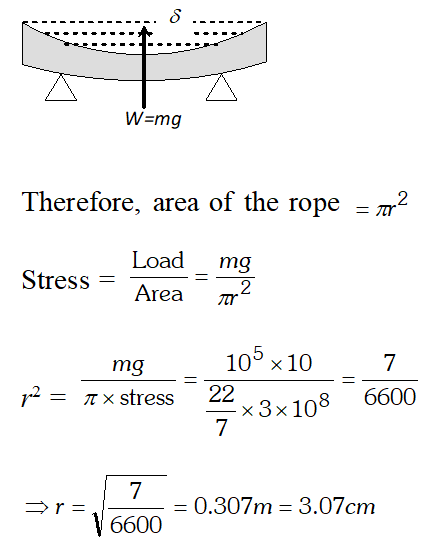 (4) To estimate the maximum height of a mountain.
(5) Bending of metallic bar. When a metallic bar of length l breadth b and thickness d placed on two wedges as shown in figure is loaded at the middle with a weight W = mg then depression in the bar is given by
$ \delta = \frac{m g l^{3}}{b d^{3} y}$
where y is the young’s modulus of the bar
(4) To estimate the maximum height of a mountain.
(5) Bending of metallic bar. When a metallic bar of length l breadth b and thickness d placed on two wedges as shown in figure is loaded at the middle with a weight W = mg then depression in the bar is given by
$ \delta = \frac{m g l^{3}}{b d^{3} y}$
where y is the young’s modulus of the bar
 (4) To estimate the maximum height of a mountain.
(5) Bending of metallic bar. When a metallic bar of length l breadth b and thickness d placed on two wedges as shown in figure is loaded at the middle with a weight W = mg then depression in the bar is given by
$ \delta = \frac{m g l^{3}}{b d^{3} y}$
where y is the young’s modulus of the bar
(4) To estimate the maximum height of a mountain.
(5) Bending of metallic bar. When a metallic bar of length l breadth b and thickness d placed on two wedges as shown in figure is loaded at the middle with a weight W = mg then depression in the bar is given by
$ \delta = \frac{m g l^{3}}{b d^{3} y}$
where y is the young’s modulus of the bar
Q. Find the excess pressure inside a liquid drop.
Ans. If the liquid surface is curved, then in equilibrium a net pressure acts on it towards the concave side or the pressure on the concave side is larger than that of convex side.
A liquid drop is spherical in shape and its outer surface is convex. Therefore, due to surface tension a net inward force acts on every molecule situated on the surface of the drop. As a result the pressure inside the drop is more than that of outside.
Let the radius of drop be R and the excess pressure inside it is P. Due to this excess pressure an outward force acts on the surface of the drop.
Let due to the excess of pressure the radius of
the drop increases from $R$ to $R+\Delta R$
Therefore, work done by excess of pressure in expansion of the drop.
$W=$ Force $\times$ displacement $=$ Pressure $\times$ area $\times$displacement
$W=P \times 4 \pi R^{2} \times \Delta R$
and increase in surface area of the drop $=$ Final
surface area - Initial surface area
 $\therefore$ Increase in surface energy $=T \times 8 \pi R . \Delta R$
since, this increase in surface energy is due to
excess of pressure,
$\therefore$ Increase in surface energy $=T \times 8 \pi R . \Delta R$
since, this increase in surface energy is due to
excess of pressure,
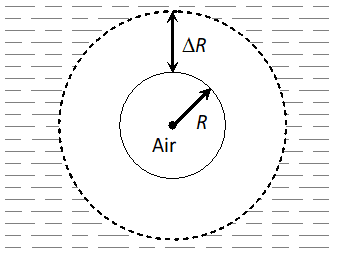 $\therefore P \times 4 \pi R^{2} \times \Delta R=T \times 8 \pi R . \Delta R \cdots P=\frac{2 T}{R}$
i.e. (i) $P \propto T \quad$ (ii) $P \propto \frac{1}{R}$
i.e. smaller the drop, greater is the excess pressure inside it.
Note : A bubble inside a liquid is similar to a liquid drop.
Let us consider an air bubble of radius R formed in a liquid of surface tension T. Like a liquid drop, the air bubble also has one surface in contact with the liquid. Hence proceeding in the same way as in case of liquid drop, we can derive an expression for excess pressure inside the air bubble.
$P=\frac{2 T}{R}$
$\therefore P \times 4 \pi R^{2} \times \Delta R=T \times 8 \pi R . \Delta R \cdots P=\frac{2 T}{R}$
i.e. (i) $P \propto T \quad$ (ii) $P \propto \frac{1}{R}$
i.e. smaller the drop, greater is the excess pressure inside it.
Note : A bubble inside a liquid is similar to a liquid drop.
Let us consider an air bubble of radius R formed in a liquid of surface tension T. Like a liquid drop, the air bubble also has one surface in contact with the liquid. Hence proceeding in the same way as in case of liquid drop, we can derive an expression for excess pressure inside the air bubble.
$P=\frac{2 T}{R}$
 $\therefore$ Increase in surface energy $=T \times 8 \pi R . \Delta R$
since, this increase in surface energy is due to
excess of pressure,
$\therefore$ Increase in surface energy $=T \times 8 \pi R . \Delta R$
since, this increase in surface energy is due to
excess of pressure,
 $\therefore P \times 4 \pi R^{2} \times \Delta R=T \times 8 \pi R . \Delta R \cdots P=\frac{2 T}{R}$
i.e. (i) $P \propto T \quad$ (ii) $P \propto \frac{1}{R}$
i.e. smaller the drop, greater is the excess pressure inside it.
Note : A bubble inside a liquid is similar to a liquid drop.
Let us consider an air bubble of radius R formed in a liquid of surface tension T. Like a liquid drop, the air bubble also has one surface in contact with the liquid. Hence proceeding in the same way as in case of liquid drop, we can derive an expression for excess pressure inside the air bubble.
$P=\frac{2 T}{R}$
$\therefore P \times 4 \pi R^{2} \times \Delta R=T \times 8 \pi R . \Delta R \cdots P=\frac{2 T}{R}$
i.e. (i) $P \propto T \quad$ (ii) $P \propto \frac{1}{R}$
i.e. smaller the drop, greater is the excess pressure inside it.
Note : A bubble inside a liquid is similar to a liquid drop.
Let us consider an air bubble of radius R formed in a liquid of surface tension T. Like a liquid drop, the air bubble also has one surface in contact with the liquid. Hence proceeding in the same way as in case of liquid drop, we can derive an expression for excess pressure inside the air bubble.
$P=\frac{2 T}{R}$
Q. Find excess pressure inside a soap bubble.
Ans. Let us consider a thin soap bubble of radius R formed from a soap solution of surface tension T.
Due to air inside it the bubble has two free surfaces, one inside and other outside
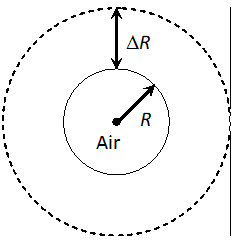 Due to excess pressure p in it an outward force acts on the surface of the bubble. This is balanced by the force due to surface tension.
Now, the work done by excess pressure $P$ in
increasing radius from $R$ to $R+\Delta R$.
$W=$ Force $\times$ displacement $=P \times 4 \pi R^{2} \times \Delta R$
and increase in surface area of the bubble
$=2\left[4 \pi(R+\Delta R)^{2}-4 \pi R^{2}\right]$
$=2\left[4 \pi\left(R^{2}+2 . R . \Delta R+\Delta R^{2}\right)-4 \pi R^{2}\right]=16 \pi R \Delta R$
$\therefore$ Increase in surface energy $=T \times 16 \pi R \Delta R$
since, the increase in surface energy is due to
excess of pressure,
$\therefore P \times 4 \pi R^{2} \times \Delta R=T \times 16 \pi R . \Delta R \quad$ i.e. $\quad P=\frac{4 T}{R}$
Due to excess pressure p in it an outward force acts on the surface of the bubble. This is balanced by the force due to surface tension.
Now, the work done by excess pressure $P$ in
increasing radius from $R$ to $R+\Delta R$.
$W=$ Force $\times$ displacement $=P \times 4 \pi R^{2} \times \Delta R$
and increase in surface area of the bubble
$=2\left[4 \pi(R+\Delta R)^{2}-4 \pi R^{2}\right]$
$=2\left[4 \pi\left(R^{2}+2 . R . \Delta R+\Delta R^{2}\right)-4 \pi R^{2}\right]=16 \pi R \Delta R$
$\therefore$ Increase in surface energy $=T \times 16 \pi R \Delta R$
since, the increase in surface energy is due to
excess of pressure,
$\therefore P \times 4 \pi R^{2} \times \Delta R=T \times 16 \pi R . \Delta R \quad$ i.e. $\quad P=\frac{4 T}{R}$
 Due to excess pressure p in it an outward force acts on the surface of the bubble. This is balanced by the force due to surface tension.
Now, the work done by excess pressure $P$ in
increasing radius from $R$ to $R+\Delta R$.
$W=$ Force $\times$ displacement $=P \times 4 \pi R^{2} \times \Delta R$
and increase in surface area of the bubble
$=2\left[4 \pi(R+\Delta R)^{2}-4 \pi R^{2}\right]$
$=2\left[4 \pi\left(R^{2}+2 . R . \Delta R+\Delta R^{2}\right)-4 \pi R^{2}\right]=16 \pi R \Delta R$
$\therefore$ Increase in surface energy $=T \times 16 \pi R \Delta R$
since, the increase in surface energy is due to
excess of pressure,
$\therefore P \times 4 \pi R^{2} \times \Delta R=T \times 16 \pi R . \Delta R \quad$ i.e. $\quad P=\frac{4 T}{R}$
Due to excess pressure p in it an outward force acts on the surface of the bubble. This is balanced by the force due to surface tension.
Now, the work done by excess pressure $P$ in
increasing radius from $R$ to $R+\Delta R$.
$W=$ Force $\times$ displacement $=P \times 4 \pi R^{2} \times \Delta R$
and increase in surface area of the bubble
$=2\left[4 \pi(R+\Delta R)^{2}-4 \pi R^{2}\right]$
$=2\left[4 \pi\left(R^{2}+2 . R . \Delta R+\Delta R^{2}\right)-4 \pi R^{2}\right]=16 \pi R \Delta R$
$\therefore$ Increase in surface energy $=T \times 16 \pi R \Delta R$
since, the increase in surface energy is due to
excess of pressure,
$\therefore P \times 4 \pi R^{2} \times \Delta R=T \times 16 \pi R . \Delta R \quad$ i.e. $\quad P=\frac{4 T}{R}$
Q. Show that there is an excess of pressure on curved surface of liquid, which is more on concave face than that on convex face of curved surface of liquid.
Ans. When the liquid surface is plane, the molecule on the liquid surface will be equally attracted on all the sides, and the forces (T, T) of surface tension will be acting tangentially to the liquid surface in opposite directions. Hence no resultant force is acting on the molecule. As a result no extra pressure exists to the inner side or outer side of liquid surface.
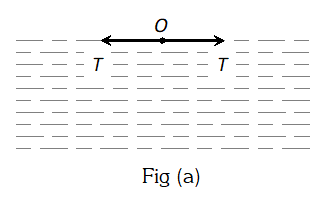 When the liquid surface is curved, the molecule O on the liquid surface is acted upon by the forces (T, T) due to surface tension along the tangents to surface. Resolving these forces into horizontal and vertical components, the horizontal components cancel each other whereas vertical components add up. Thus a resultant force acts on the curved surface of the liquid which acts towards its centre of curvature i.e. the resultant force is directed inwards in case of convex surface fig. (b) and is directed outwards in case of concave surface fig (c). In order that the curved surface of liquid may be in equilibrium, there must be an excess pressure on its concave side over that on the convex side, so that the forces of excess pressure may balance the resultant forces due to surface tension.
When the liquid surface is curved, the molecule O on the liquid surface is acted upon by the forces (T, T) due to surface tension along the tangents to surface. Resolving these forces into horizontal and vertical components, the horizontal components cancel each other whereas vertical components add up. Thus a resultant force acts on the curved surface of the liquid which acts towards its centre of curvature i.e. the resultant force is directed inwards in case of convex surface fig. (b) and is directed outwards in case of concave surface fig (c). In order that the curved surface of liquid may be in equilibrium, there must be an excess pressure on its concave side over that on the convex side, so that the forces of excess pressure may balance the resultant forces due to surface tension.
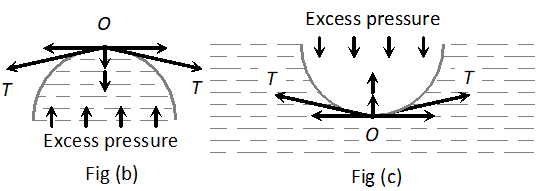 Hence, for the curved surface of liquid in equilibrium the pressure on concave side of liquid will be greater than pressure on its convex side.
Hence, for the curved surface of liquid in equilibrium the pressure on concave side of liquid will be greater than pressure on its convex side.
 When the liquid surface is curved, the molecule O on the liquid surface is acted upon by the forces (T, T) due to surface tension along the tangents to surface. Resolving these forces into horizontal and vertical components, the horizontal components cancel each other whereas vertical components add up. Thus a resultant force acts on the curved surface of the liquid which acts towards its centre of curvature i.e. the resultant force is directed inwards in case of convex surface fig. (b) and is directed outwards in case of concave surface fig (c). In order that the curved surface of liquid may be in equilibrium, there must be an excess pressure on its concave side over that on the convex side, so that the forces of excess pressure may balance the resultant forces due to surface tension.
When the liquid surface is curved, the molecule O on the liquid surface is acted upon by the forces (T, T) due to surface tension along the tangents to surface. Resolving these forces into horizontal and vertical components, the horizontal components cancel each other whereas vertical components add up. Thus a resultant force acts on the curved surface of the liquid which acts towards its centre of curvature i.e. the resultant force is directed inwards in case of convex surface fig. (b) and is directed outwards in case of concave surface fig (c). In order that the curved surface of liquid may be in equilibrium, there must be an excess pressure on its concave side over that on the convex side, so that the forces of excess pressure may balance the resultant forces due to surface tension.
 Hence, for the curved surface of liquid in equilibrium the pressure on concave side of liquid will be greater than pressure on its convex side.
Hence, for the curved surface of liquid in equilibrium the pressure on concave side of liquid will be greater than pressure on its convex side.
Q. What is capillarity and deduce ascent formula.
Ans. The phenomenon of ascent or descent of liquid in a capillary tube is called capillarity or capillary action.
Generally those liquids which wet the glass surface rises up and the liquids which do not wet the glass surface descend in the capillary.
Ascent formulla : Let a uniform capillary tube of radius ‘r’ is dipped into a liquid in which liquid rises upto height ‘h’. Considering the meniscus (concave) radius nearly equal to the radius of capillary, the surface tension of liquid acts at the point of contact of meniscus along the direction of tangent making an angle q (angle of contact) with the wall of capillary tube. The horizontal and vertical components of T are Tsinq and Tcosq. The horizontal component Tsinq acting diametrically opposite around the meniscus cancel each other. But the vertical component Tcosq acts upwardly around the circumference of meniscus, due to which rises the liquid in the capillary tube.
\[\therefore \]Force which rises the liquid $=T \cos \theta .2 \pi r$
This force is balanced by the weight of the liquid.
Now, the volume of liquid raised = V = Volume of liquid upto height h + Volume of liquid in meniscus.
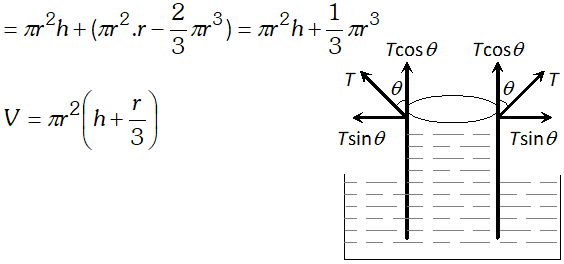
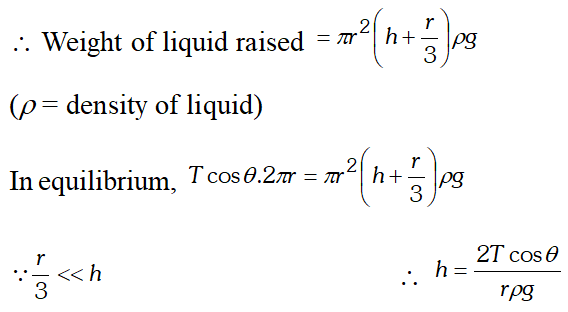
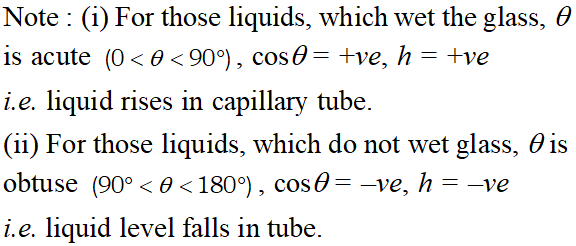
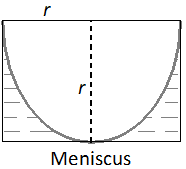




Q. What do you understand by Reynold’s number? Give its physical significance.
Ans. Reynold number is a pure number which determines the nature of flow of liquid through a pipe. According to Reynold, the critical velocity $v_{c}$ of a liquid flowing through a tube of diameter D is given by.
$v_{c}=\frac{k \eta}{\rho D} \Rightarrow K=\frac{\rho D V_{c}}{\eta}$
when, $\eta=$ coefficient of viscosity of liquid.
$K=A$ constant and is called Reynold's number
$\rho=$ density of liquid
The value of K lies between 0 to 2000, for streamline or laminar flow and for value K above 3000, the flow of liquid is turbulent.
Physical significance : Reynold’s number describes the ratio of the inertial force per unit area to the viscous force per unit area for a flowing fluid.
Let us consider a tube of small area of cross section A, through which a fluid of density r is flowing with velocity v.
The mass of fluid flowing through the tube per second,
$\Delta m=$ volume flowing per second $\times$ density.
$=A v \rho$
\[\therefore \]Inertial force per unit area
$=\frac{\text { rate of change of momentum }}{\text { Area }}$
$=\frac{(\Delta m) v}{A}=\frac{(A v \rho) v}{A}=v^{2} \rho$
and viscous force, $F=\eta A \frac{v}{r}$ (in magnitude)
where $r=$ radius of tube
$\frac{v}{r}=$ velocity gradient between the layers of this
liquid flow.
$\therefore$ viscous force per unit area, $=\frac{F}{A}=\frac{\eta v}{r}$
Hence, Reynold's number,
$\mathrm{K}=\frac{\text { Inertial force per unit area }} {\text { viscous force per unit area }}=\frac{v^{2} \rho}{\eta v / r}=\frac{v \rho r}{\eta}$
